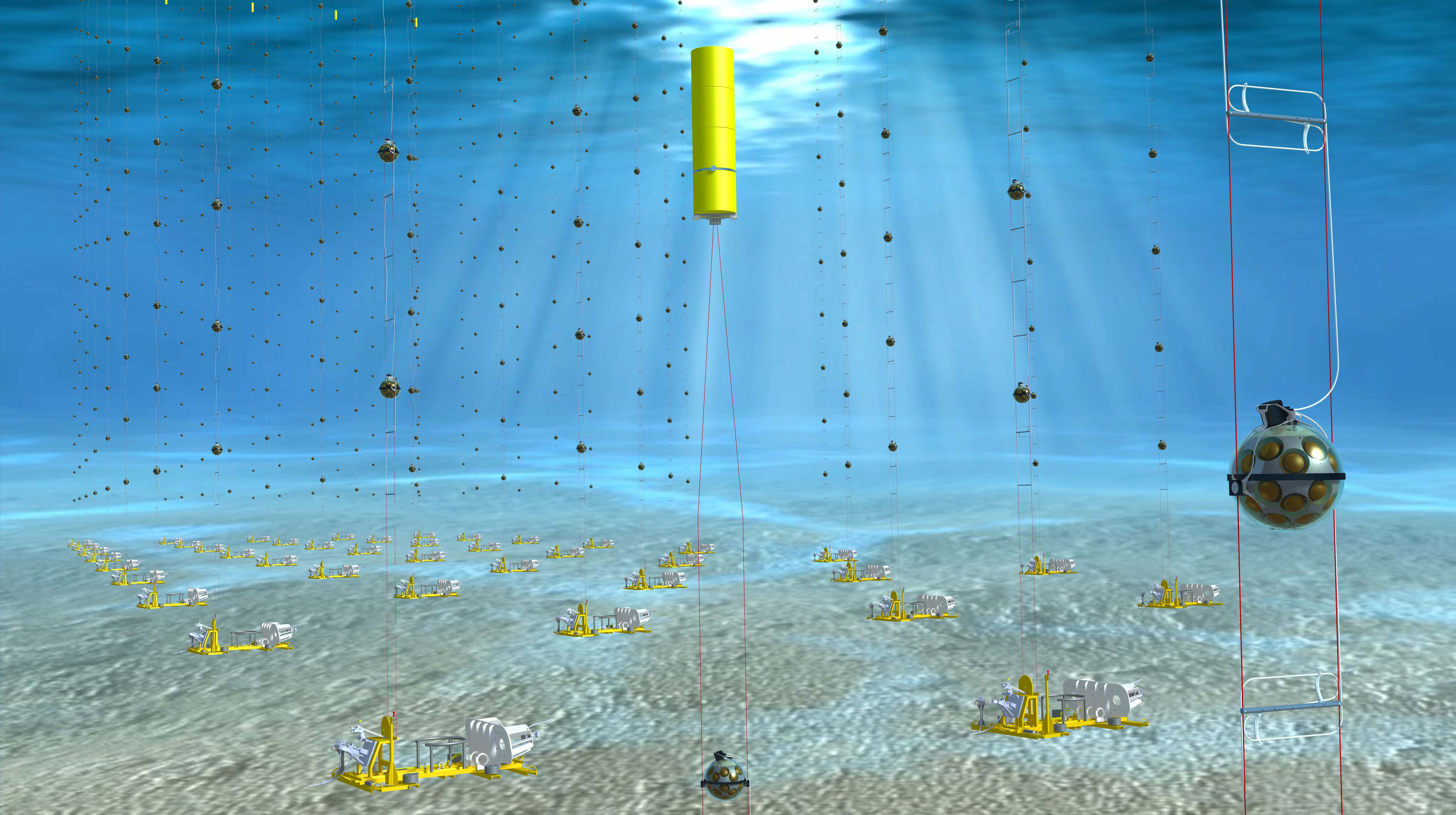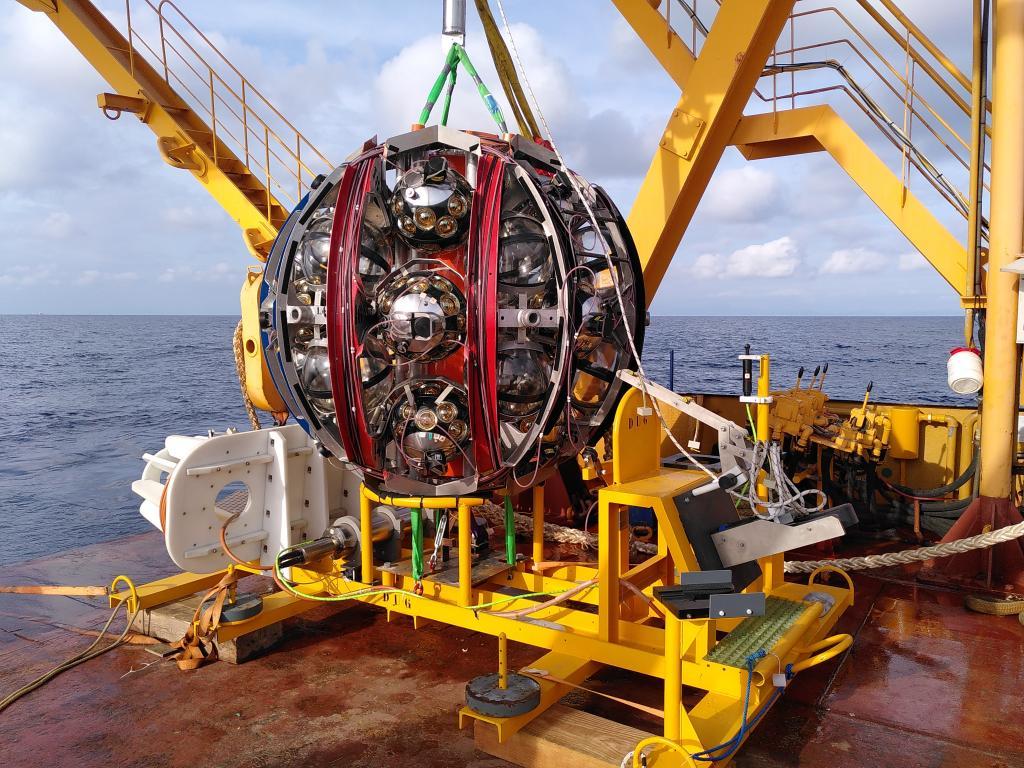
The observation of the universe has traditionally been done through photons. However, at high energies photons tend to be absorbed by interstellar matter and the cosmic microwave background. In this context, the distant high energy sky, that of the cataclysmic phenomena of the childhood of the Universe, is concealed from the astronomer.
But a new messenger, the neutrino, can open a new window into these mysteries. Neutral and light, the neutrino barely interacts with matter. This gives it both the possibility of escaping from the densest zones of the Universe and of traversing cosmological distances without suffering any alteration. For the same reason, however, the neutrino is also very difficult to observe. In order to study these cosmic neutrinos, neutrino telescopes instrument huge volumes of water with photomultiplier tubes to capture the rare interactions of these elusive particles.
Atmospheric neutrinos have traditionally been considered as background noise for the detection of astrophysical neutrinos. In recent years, however, it has been realized that at GeV energies this flux holds the key to solving a fundamental question of particle physics: that of the neutrino mass hierarchy. The question boils down to: Are the neutrino states associated mostly with the lightest charged lepton (the electron) also the lightest neutrino states (normal hierarchy) or are they the heaviest (inverted hierarchy)? To answer this question, neutrino telescopes can measure the pattern of atmospheric neutrino oscillations looking for characteristic resonances due to the refraction of neutrinos inside the Earth.
The APC team is involved in two neutrino telescope projects in the Mediterranean Sea: ANTARES and KM3NeT.
The ANTARES detector was operated continuously from 2007 to 2022, demonstrating the feasibility of an undersea neutrino telescope. This telescope comprised 12 detection lines harnessed with photomultipliers intended to identify the path of light left by the daughter particles of the neutrinos after their interaction in the vicinity.
The APC team is responsible for the charge calibration and data quality monitoring of the detector, which are crucial to achieve and maintain the best possible detector performance over the years. The last five years have been particularly fruitful for the scientific exploitation of ANTARES data, with several key contributions from the APC group to constrain the origin of the cosmic neutrino flux. The ANTARES detector was disconnected in February 2022, and the activity of the team members is progressively shifting to KM3NeT, although analysis activities on the final dataset will continue for a couple of years.
KM3NeT is the next-generation neutrino telescope currently under construction on two abyssal sites in the Mediterranean Sea: ORCA near Toulon, France, and ARCA near Capo Passero, Sicily. While ORCA is primarily dedicated to fundamental neutrino physics studies at GeV energies, ARCA’s main goal is high-energy (TeV-PeV) neutrino astronomy. The completion of the full ORCA and ARCA arrays are planned for 2027 and both detectors are expected to run for at least 10 years.
The scientific activities of the group are currently focused on neutrino physics studies with ORCA and on evaluating the potential of both ORCA and ARCA for low-energy, sub-GeV, neutrino astronomy, with a particular interest in the possibility to detect MeV neutrinos from core-collapse supernovae. The team is heavily involved in the measurement of the neutrino mass hierarchy, as well as developing searches for physics beyond the standard model. The team is also spearheading an interdisciplinary project to explore the potential of neutrino detectors to measure properties of the Earth’s interior.
On the technical side, the group operates in the lab assembly hall an 8 m³ water tank surrounded by scintillators for the characterization of the DOM acceptance and response to atmospheric muons. The team, in collaboration with CPPM, is also in charge of the design and construction of the first KM3NeT Calibration Unit to be deployed in the upcoming months on the ORCA site.

Team members
Physicists:
- AUBLIN Julien
- BARET Bruny
- BECHERINI Yvonne
- COELHO Joao (résponsable du groupe)
- COLEIRO Alexis
- CREUSOT Alexandre
- DONZAUD Corinne
- EL HEDRI Sonia
- KOUCHNER Antoine
- TROCMÉ Benjamin
- VAN ELEWYCK Véronique
- YVON Isabelle
Engineers & technicians:
Post-docs:
- GOOS Isabel (LEAK project)
- GOSWAMI Pranjupriya (AstrodiiP)
- PESTES Rebekah (ARGOS project)
- SHARMA Ankur (AstrodiiP)
PhD Students:
- BENDAHMAN Meriem (2020-2023): Evaluation of the low energy astrophysics potential of KM3NeT with deep learning techniques.
- CARTRAUD Théophile (2022-2025): Search for high-energy cosmic neutrinos.
- EFF Maximilian (2023-2026) Optimisation of the search for extragalactic neutrinos with advanced analysis techniques and follow-up with H.E.S.S.
- OUKACHA Enzo (2022-2025): Search for neutrino-gamma correlations in the high-energy extragalactic sky.
- PEÑA MARTÍNEZ Santiago (2022-2025): Deeply Learning from Neutrino Interactions with the KM3NeT neutrino telescope.
For more details: APC Activity Report
Useful Links
- ANTARES experiment: antares.in2p3.fr (InspireHEP)
- KM3NeT experiment: www.km3net.org (InspireHEP)
